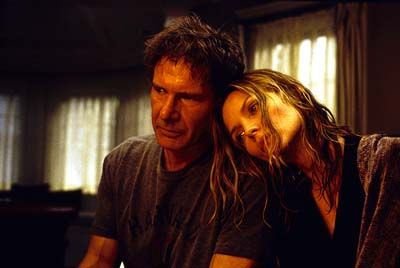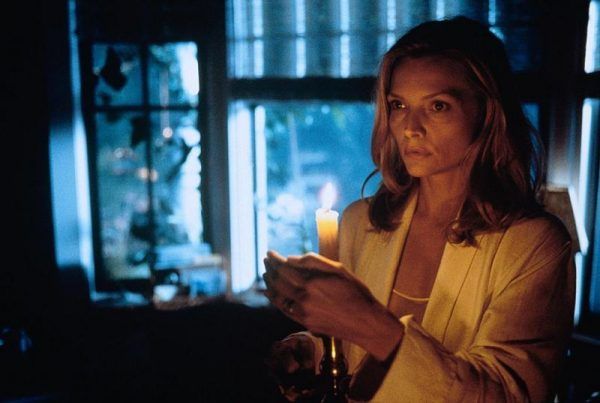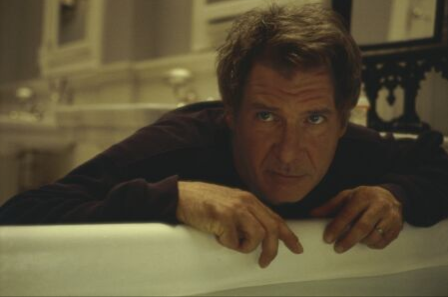What Lies Beneath, released in theaters 20 years ago this month, is a supernatural horror thriller that Robert Zemeckis made in the middle of directing Cast Away while waiting for Tom Hanks to transform himself into a gangly bearded scarecrow. It was essentially the cinematic equivalent of a pick-up game, except in this metaphor Harrison Ford and Michelle Pfeiffer were chasing frogs around the sandlot when Robert Zemeckis showed up with a bat and a glove. This has already gone screaming off the rails, so let me regain control by saying What Lies Beneath is an excellent genre homage that asks the question, “What if Alfred Hitchcock had made a movie about ghosts?” It plays a number of tricks on the audience right up until the film’s creepy climax, and arguably one of the best tricks it has up its sleeve is its cast. Not their characters or performances, although both Pfeiffer and Ford are extremely good in it. No, what makes What Lies Beneath so effective is how it plays with what its audience knows about Harrison Ford, the actor.
If you haven’t seen What Lies Beneath, be aware that I’m about to spoil the shit out of it. It’s currently available to stream on Amazon Prime, and also it came out two decades ago, so really the ball is in your court at this point.
The movie is about Claire Spencer (Pfeiffer), a former concert cellist turned stay-at-home mom who feels directionless after sending her only daughter off to college. She overhears her neighbor Mary (Miranda Otto, who would play Eowyn in the Lord of the Rings trilogy just two years later) having a terrified breakdown in the backyard. When Mary seemingly disappears the next day, Claire becomes convinced she’s been murdered and that her ghost is haunting the Spencer house. Ford plays her husband Norman, a workaholic research professor whose increasingly long hours in the lab are leaving Claire alone in the house for extended periods of creepification, which include eerie messages scrawled onto misty bathroom mirrors and objects and doors moving on their own. Apparently Mary’s ghost got lost trying to haunt her own house and stumbled next door, spookily knocking over picture frames in her frantic struggle to discover what happened to all of her furniture.
Zemeckis lays the film’s first major twist on us fairly early on, when Claire finally accuses Mary’s husband Warren (James Remar) of the murder, only to have a very much not murdered Mary walk over in confusion. It may be the only time in cinema history that James Remar was not guilty of a crime. So, who is the ghost? And is there even really a ghost, or is Claire just seeing things? In its only real misstep, What Lies Beneath blows right through this interesting possibility. It does pose the question, but it never takes the idea seriously, so what could’ve been another intriguing twist just falls flat because the audience already fully believes Claire is being haunted. The only twist left is by whom? Or so it seems.
The ghost turns out to be that of a young graduate student named Madison who disappeared mysteriously the year before, while Norman was having an affair with her. Claire discovered them together just before having a terrible car accident that suppressed the memory, but a visit from the ghost brings it all back. At first, Norman admits to the affair and insists that he doesn’t know what happened to Madison, telling Claire that she threatened to kill herself after he broke it off. But Claire eventually finds a box containing Madison’s jewelry that Norman hid in the lake behind their house, and he changes his story to say that he came home one night to find that Madison had killed herself in their house, obliging him to dispose of the body so he wouldn’t jeopardize his entire career. When Claire insists he call the police to confess, the mask finally comes all the way off, and this seriously is the final twist – Norman straight-up murdered Madison, and now he’s going to straight-up murder Claire, too. She spends the last 20 minutes of the film in a Hitchcockian game of cat and mouse, which culminates in Norman getting drowned in the lake by Madison’s ghost, only slightly more surprised than he was when he got stabbed by Kylo Ren.
If Zemeckis had cast virtually any other actor as Norman, we would’ve seen that last twist coming a mile away. If the film opened with, say, Michael Douglas walking into a room and saying, “Hi, I’m Dr. Norman Spencer,” I would’ve immediately said, “Oh, this guy is the fucking murderer.” And I would have been 100% correct. The effectiveness of What Lies Beneath’s third act depends almost entirely on the viewer’s familiarity with Ford as an actor, and specifically with one unusual aspect of his career – he never plays villains. He’s played gruff characters, deeply flawed characters, and even unlikeable characters, but never the bad guy. The idea that Norman is the killer never enters our minds, and even when he starts changing his story and the details begin to unravel, we still can’t conceive of the idea that Harrison Ford murdered a lady. Han Solo threw that woman into the lake? Impossible, he would never do such a thing. It’s like casting Jimmy Stewart as the BTK killer. We simply would not believe it until he started stabbing someone to death on screen.
When What Lies Beneath was released in 2000, much of the marketing campaign focused on Ford’s character, including the tagline – “He was the perfect husband until his one mistake followed them home.” That’s objectively a godawful synopsis that gives away too much of the film’s plot, but the bigger point to be made is that audiences were essentially being told Harrison Ford was the main character. Similarly, the trailer heavily focused on the scenes in which Pfeiffer is creepily possessed by Madison’s ghost, so I went into the theater thinking What Lies Beneath was going to be more like The Exorcist or The Shining. My brain was nowhere near the neighborhood of domestic thriller, nor the smaller gated community in which beloved actor Harrison Ford drowns women in his bathtub. And his performance in the final 20 minutes is downright bone-chilling, amplified by the fact that I’m shouting “We trusted you!” at the screen in between horrified gasps.
Surprisingly (at least to me), while What Lies Beneath was a considerable box office success, it received a very lukewarm response from critics. And that’s dumb, because this movie rules. But seriously, I genuinely consider it to be one of the best thrillers I’ve ever seen, due in large part to the meta-casting of an iconic movie hero as the murderous villain. And it was absolutely intentional – Zemeckis has said that Ford and Pfeiffer were his first and only choices, and Ford apparently cleared his schedule for the role. It seems like everyone involved knew this was a one-time opportunity to truly pull the wool over audiences’ eyes, so they’d better make it worth it. Add that to some expertly creepy directing from Zemeckis (loaded with Hitchcock homages) and a strong lead performance from Pfeiffer, and you’ve got an all-time spookfest that I’ve been regularly rewatching for two decades now. Every time I cue it up, I say a quiet word of thanks to Tom Hanks for his desert island crash diet that brought us What Lies Beneath. I give Hanks, if you will. That said, I have still never seen Cast Away.
Tom Reimann is an associate editor at Collider and is 78% certain he is not being possessed by a bathtub ghost. You can follow him on Twitter at @startthemachine.




